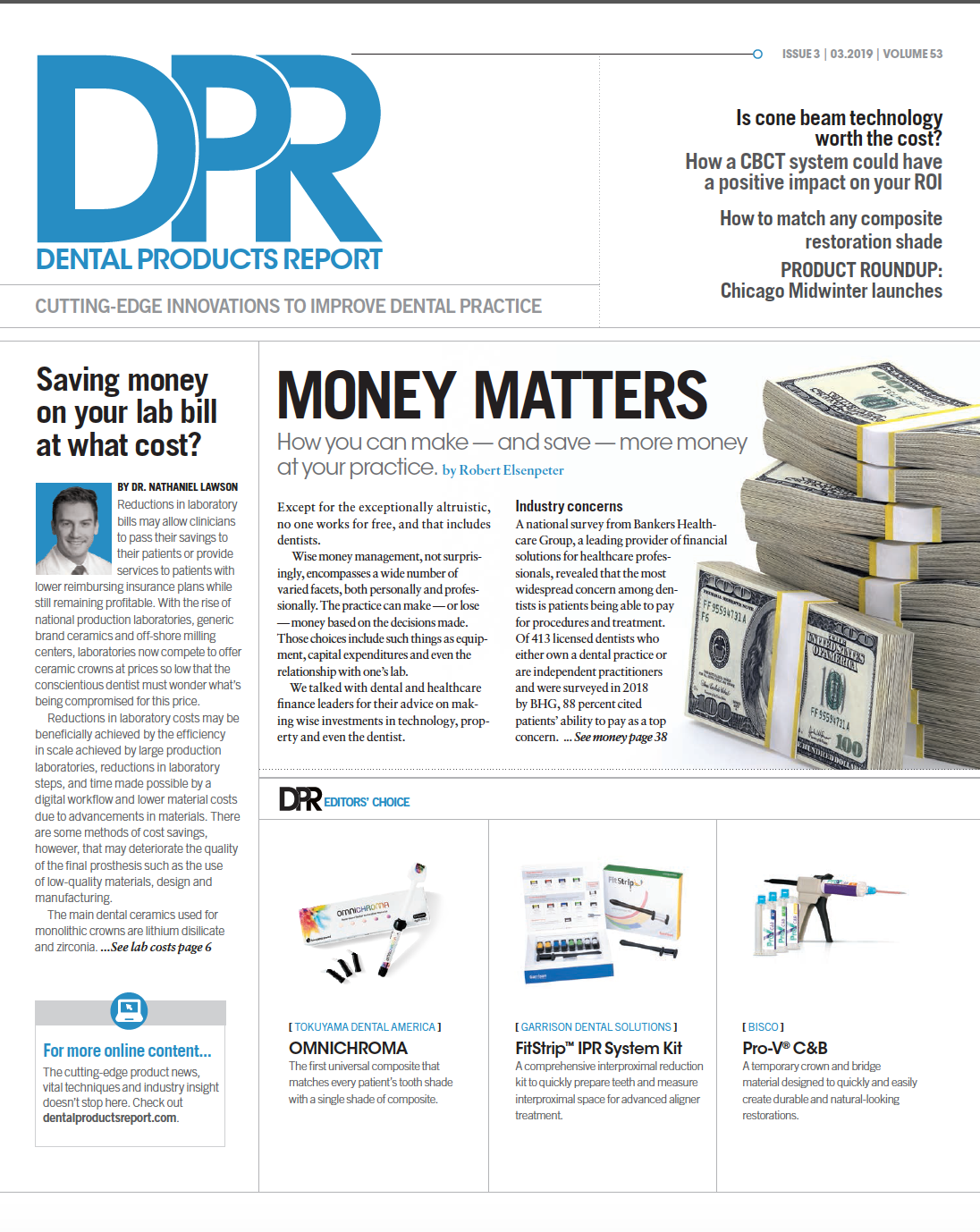How to save money by preventing sensitivity
Redoing procedures increases your overhead and eats away at your gross operating revenue. Here’s how you can complete the perfect procedure the first time around

For those of you over the age of 45, you may remember a character from “Saturday Night Live.” His name was Father Guido Sarducci and was played by comedian Don Novello. In the guise of a Catholic priest, he would offer life lessons as part of Weekend Update.
One of his best bits was The Five Minute University, where he teaches “everything you’ll remember from college classes five years after you’re out of school.” For economics, he says, “supply and demand.” For business, “Buy something at one price and sell it for more.” It’s a great bit that you can view at will on YouTube. Every time I watch it, I laugh.
If you want to run a successful business, you have to have more money coming in the door than is leaving.
One of the things that happens in dentistry that can severely affect things is remakes/redos. My grandpa Flucke used to tell me, “Son, there’s never time to do it right, but there’s always time to do it over.” That little phrase has stuck with me for my entire life, and it certainly holds true for the practice of dentistry.
Having to do something over can have a tremendous impact on your practice. Financially, your overhead continues and the cost of the procedure is being fed by the gross operating revenue of the office. It also affects your scheduling. You’re eliminating time in your schedule that should be devoted to profits, and this compounds to affect your ability to see a patient who would love to be seen for a revenue-generating procedure. Finally, it affects your actual internal marketing strategy. No matter the reason for a redo, you run the risk of a patient losing faith in you. That loss of faith can affect the patient’s desire to refer you or even result in the patient leaving the practice.
Trending article: 4 reasons to reevaluate your materials inventory
I’ll never fault someone for doing the right thing and sometimes, despite our very best efforts, things don’t go as planned, which necessitates redoing something. Handling these cases the right way can even be a practice booster because the patient understands that your desire to do things perfectly outweighs everything else. The best way to avoid the whole scenario is to do everything possible to avoid the situation in the first place. This month let’s take a look at some ways to head off potential problems and keep our redos to a minimum.
Hemostasis and fluid control

When it comes to adhesive dentistry, one of the biggest negative factors we have in bonding is contamination. Whether it’s blood, saliva, or crevicular fluid, any type of biological contamination can directly affect bond strengths. This can lead to sensitivity, marginal leakage/breakdown and shorter lifespan of the restoration. When sensitivity is the issue, we’re often faced with replacing the restoration.
In order to prevent contamination with blood, there are a couple of handy chemistries available that I use routinely. One is ViscoStat®, which is a 20 percent ferric sulfate solution. It does a great job of quickly controlling bleeding. The only drawback is that, due to the iron content, it stains the tissue and has the possibility of making the margin of the restoration appear dark. In the esthetic zone, my agent of choice is ViscoStat® Clear, which is 25 percent aluminum chloride. It isn’t as strong as VicoStat, but since it’s clear, there’s no concern with staining. I also use ViscoStat Clear on Class V restorations, as the AlCl3 absorbs crevicular fluid and prevents contamination at the gingival margin.
Fluid control can also be prevented through proper use of the rubber dam. I know a lot of you just rolled your eyes at that last sentence, but hear me out. I don’t really think the rubber dam is that difficult to use if you use the right one.
There are a few brands on the market that now have a built-in flexible plastic frame, that are an all-in-one piece, pre-assembled and ready to go when you open the box. I truly don’t think it’s the dam we hate dealing with - it’s the dam frame (pun intended). These all-in-one systems allow the assistant to place the clamp and then simply snap the assembled dam over it. The process is simple and can be accomplished in just a few seconds. My current favorite is the Insti-Dam and the Relaxed-Fit Insti-Dam from Zirc. Both are latex-free and very durable. You can find others from Aseptico and Hygienic as well.
Continue to page two to read more...
The bonding process
One of the other big keys to success and, thus, eliminating redos is the science behind the bonding process. A big part of any general dental practice is simple operative. Because of that, it behooves us to be really proficient at the science and art of the discipline. You can’t cheat physics and chemistry.
There are a lot of restorative solutions and systems on the market; however, for the best bond strengths and long-term viability of the restoration, it’s best to use a fourth- or fifth-generation technique. Fourth-generation is total-etch with the use of a separate dentin primer and a separate adhesive. Fifth-generation is total-etch with the use of a single agent that’s dentin primer and adhesive in one agent. Since the bond strengths of the two techniques are pretty close, I choose fifth-generation due to the efficiency of saving a step.
My technique is the following:
- Dry preparation.
- Apply etch and leave in place 15 seconds.
- Rinse and remove all etch.
- Lightly apply air to remove excess moisture; do NOT overdry.
- Visually check prep. If any areas appear dry, reapply water and dry less vigorously.
- Apply bonding agent. Currently, my preferred agent is Peak®.
- Scrub bonding agent into all areas of the prep for 10 seconds.
- Apply a light steam of air from about 10 mm away for 10 seconds. This will thin the bonding agent and evaporate the solvent.
- Cure for 10 seconds.
- Place composite in 2-3 mm increments unless it’s bulk fill.
- Cure for multiple cycles at multiple angle.
Related reading: 5 mistakes you might be making with composites
Providing the cure
The other piece of the sensitivity puzzle that requires solving is the process and the mechanics of the curing light. Curing light wavelength and intensity are critical to the success of the restoration. Buying a curing light over the internet for $100 isn’t much of a savings if you have no idea what wavelength of blue it generates. It doesn’t take many failed restorations to destroy the savings or your reputation.
The curing light is an intrinsic part of the process and one that can’t be discounted in any way, shape, or form. Almost every composite uses the photoinitiator camphorquinone. It requires a light that has output in the 465 nm range. (Any decent light available from a name brand manufacturer will have this). I would especially advise a light with a minimum output of 1000 mw/cm2. Check the specs before you purchase. My favorite current favorite light is the Ultradent VALO® Grand.
The actual process of curing is also critically important. The best light in the world will not make up for poor technique. First of all, barrier protect the device. This keeps resin from sticking to the light, which can build up over time and cut the light’s output. Also, make sure to get as close to the composite as possible - the further from the target the light is, the less curing power you have. Insufficient distance creates a composite that’s cured on the surface,but not properly cured at the pulpal floor, leading to sensitivity, which causes failure.
Wrapping up
Sometimes even the best situations don’t end up as planned. That guy Murphy can sneak into any moment in dentistry. Perfection is unattainable, but with good effort and attention to detail, we can all make our lives, and those of our patients, a little bit better.
